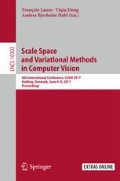Abstract
The Riemannian metamorphosis model introduced and analyzed in [7, 12] is taken into account to develop an image extrapolation tool in the space of images. To this end, the variational time discretization for the geodesic interpolation proposed in [2] is picked up to define a discrete exponential map. For a given weakly differentiable initial image and a sufficiently small initial image variation it is shown how to compute a discrete geodesic extrapolation path in the space of images. The resulting discrete paths are indeed local minimizers of the corresponding discrete path energy. A spatial Galerkin discretization with cubic splines on coarse meshes for image deformations and piecewise bilinear finite elements on fine meshes for image intensity functions is used to derive a fully practical algorithm. The method is applied to real images and image variations recorded with a digital camera.
Access this chapter
Tax calculation will be finalised at checkout
Purchases are for personal use only
Notes
- 1.
First painting by A. Kauffmann (public domain, see http://commons.wikimedia.org/wiki/File:AngelikaspsKauffmannsps-spsSelfspsPortraitsps-sps1784.jpg), second painting by R. Peale (GFDL, see http://en.wikipedia.org/wiki/File:MaryspsDenison.jpg).
References
Beg, M.F., Miller, M.I., Trouvé, A., Younes, L.: Computing large deformation metric mappings via geodesic flows of diffeomorphisms. Int. J. Comput. Vis. 61(2), 139–157 (2005)
Berkels, B., Effland, A., Rumpf, M.: Time discrete geodesic paths in the space of images. SIAM J. Imaging Sci. 8(3), 1457–1488 (2015)
Dupuis, P., Grenander, U., Miller, M.I.: Variational problems on flows of diffeomorphisms for image matching. Q. Appl. Math. 56, 587–600 (1998)
Holm, D., Trouvé, A., Younes, L.: The Euler-Poincaré theory of metamorphosis. Q. Appl. Math. 67, 661–685 (2009)
Klingenberg, W.P.A.: Riemannian Geometry. de Gruyter Studies in Mathematics, vol. 1, 2nd edn. Walter de Gruyter & Co., Berlin (1995)
Lorenzi, M., Pennec, X.: Geodesics, parallel transport & one-parameter subgroups for diffeomorphic image registration. Int. J. Comput. Vis. 105(2), 111–127 (2013)
Miller, M.I., Younes, L.: Group actions, homeomorphisms, and matching: a general framework. Int. J. Comput. Vis. 41(1–2), 61–84 (2001)
Perona, P., Malik, J.: Scale-space and edge detection using anisotropic diffusion. IEEE Trans. Pattern Anal. Mach. Intell. 12(7), 629–639 (1990)
Rumpf, M., Wirth, B.: Variational time discretization of geodesic calculus. IMA J. Numer. Anal. 35(3), 1011–1046 (2015)
Trouvé, A.: Diffeomorphisms groups and pattern matching in image analysis. Int. J. Comput. Vis. 28(3), 213–221 (1998)
Trouvé, A., Younes, L.: Local geometry of deformable templates. SIAM J. Math. Anal. 37(1), 17–59 (2005)
Trouvé, A., Younes, L.: Metamorphoses through Lie group action. Found. Comput. Math. 5(2), 173–198 (2005)
Vialard, F.-X., Risser, L., Rueckert, D., Cotter, C.J.: Diffeomorphic 3D image registration via geodesic shooting using an efficient adjoint calculation. Int. J. Comput. Vis. 97, 229–241 (2012)
Vialard, F.-X., Risser, L., Rueckert, D., Holm, D.D.: Diffeomorphic atlas estimation using geodesic shooting on volumetric images. Ann. BMVA 2012, 1–12 (2012)
Author information
Authors and Affiliations
Corresponding author
Editor information
Editors and Affiliations
A Appendix
A Appendix
Here, we derive Eq. (9) from the system of Euler-Lagrange equations (6), (7) and (8). By using the transformation formula the energy \(\mathcal {W}^D\) can be rewritten as follows
Now we rewrite the Euler-Lagrange equation (8). To this end, we use that
which follows by differentiating \((\phi _2+\epsilon \psi )\circ (\phi _2+\epsilon \psi )^{-1}={\mathbbm {1}}\) with respect to \(\epsilon \), and that \(\partial _A\det (A)(B)={{\mathrm{cof}}}(A):B\) for \(A\in GL(n)\) and \(B\in \mathbb {R}^{n,n}\) with \({{\mathrm{cof}}}A = (\det A)A^{-T}\). Thus, we obtain
A further application of the transformation formula with respect to \(\phi _2\) yields
To remove the dependency of the function \({u}_2\) above, we employ the pointwise condition
for a.e. \(x\in \varOmega \), which directly follows from (6). Inserting this in (13) and using the integral transformation formula we achieve
Here, we take into account the identity \({{\mathrm{cof}}}(A)=\det (A)A^{-T}\). Next, we consider the test function \(\zeta :=((D\phi _2)^{-1}\psi )\circ \phi _1\) in (7). To justify this, we need a regularity result for polyharmonic PDEs to show \(\zeta \in H^{2m}_0(\varOmega )\). Inserting \(\zeta \) into (7) we get
By adding this identity to the above equation we finally obtain (9).
Rights and permissions
Copyright information
© 2017 Springer International Publishing AG
About this paper
Cite this paper
Effland, A., Rumpf, M., Schäfer, F. (2017). Time Discrete Extrapolation in a Riemannian Space of Images. In: Lauze, F., Dong, Y., Dahl, A. (eds) Scale Space and Variational Methods in Computer Vision. SSVM 2017. Lecture Notes in Computer Science(), vol 10302. Springer, Cham. https://doi.org/10.1007/978-3-319-58771-4_38
Download citation
DOI: https://doi.org/10.1007/978-3-319-58771-4_38
Published:
Publisher Name: Springer, Cham
Print ISBN: 978-3-319-58770-7
Online ISBN: 978-3-319-58771-4
eBook Packages: Computer ScienceComputer Science (R0)

